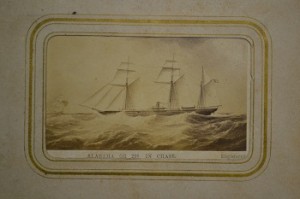By: Kevin Ray, Archival Technician
This post is the first of three posts in a week-long series describing the history of the CSS Alabama and the resources available in the Division of Special Collections on both this ship and the naval history of the Confederacy. June 19, 2014 is the 150th anniversary of the battle between the CSS Alabama and the USS Kearsarge, which resulted in the sinking of the Alabama.
Today she rests at a depth of 190 feet off the coast of Cherbourg, France. She sank in battle 150 years ago, on June 19, 1864, after a two year cruise that resulted in the capture and sinking of 65 U.S. merchant ships and 1 U.S. Navy ship. Built in England, she sailed under the Confederate flag and spent almost her entire two years of service at sea, never dropping anchor in a Southern port. She influenced the both the American Civil War and international law. Known to the world as CSS Alabama, she was the most successful commerce raider of the Civil War.
CSS Alabama was built in secrecy in Birkenhead, England in 1862, by John Laird and Sons and was first known simply as ship 290. James D. Bulloch, the Confederate foreign agent in Britain, oversaw the construction. Thomas H. Dudley, the U.S. Consul in Liverpool, pressed the British government to impound 290, insisting that she was being built for the Confederate Navy in violation of Britain’s position of neutrality. The two men were in a race to see whether Bulloch could build faster than Dudley could gather information. In a tight contest, Bulloch won. Ship 290, now christened Enrica, sailed out of Birkenhead on the evening of July 29, 1863. She made her way to the Azores to take on supplies and armament. While there, she was boarded by her new captain, Raphael Semmes. On August 25, the Confederate flag was raised and Enrica was re-named CSS Alabama.

Ralph Semmes, captain of the CSS Alabama, image taken from Memoirs of Service Afloat during the War Between the States (1869) Alabama Collection E599.A3 S64
Departing the Azores on August 26, Alabama claimed her first prize on September 6. She raided commerce vessels in the Eastern Atlantic, along the East Coast of the United States, and in the Gulf of Mexico. There, in January, 1863, Alabama sank the Union warship USS Hatteras near Galveston, Texas. From the Gulf of Mexico, Alabama steamed to the South Atlantic where she claimed a total of 29 ships captured or burned. One prize, the bark Conrad, was captured on June 20, 1863, and re-commissioned by Captain Semmes as CSS Tuscaloosa. Semmes ordered Lieutenant John Low to take command of the new Confederate ship. The two commerce raiders then headed to the South African coast. Tuscaloosa was later seized in South Africa for violating British neutrality.
In September, 1863, Alabama traveled into the Indian Ocean. She went as far as the Indonesian Islands before returning west. This raid into Southeast Asian waters nearly resulted in battle with the USS Wyoming, which was on a mission to destroy the allusive Confederate raider. The two ships never met, and Semmes returned to Cape Town, South Africa.
Come back on Wednesday, June 18 to read the next part of the story!

